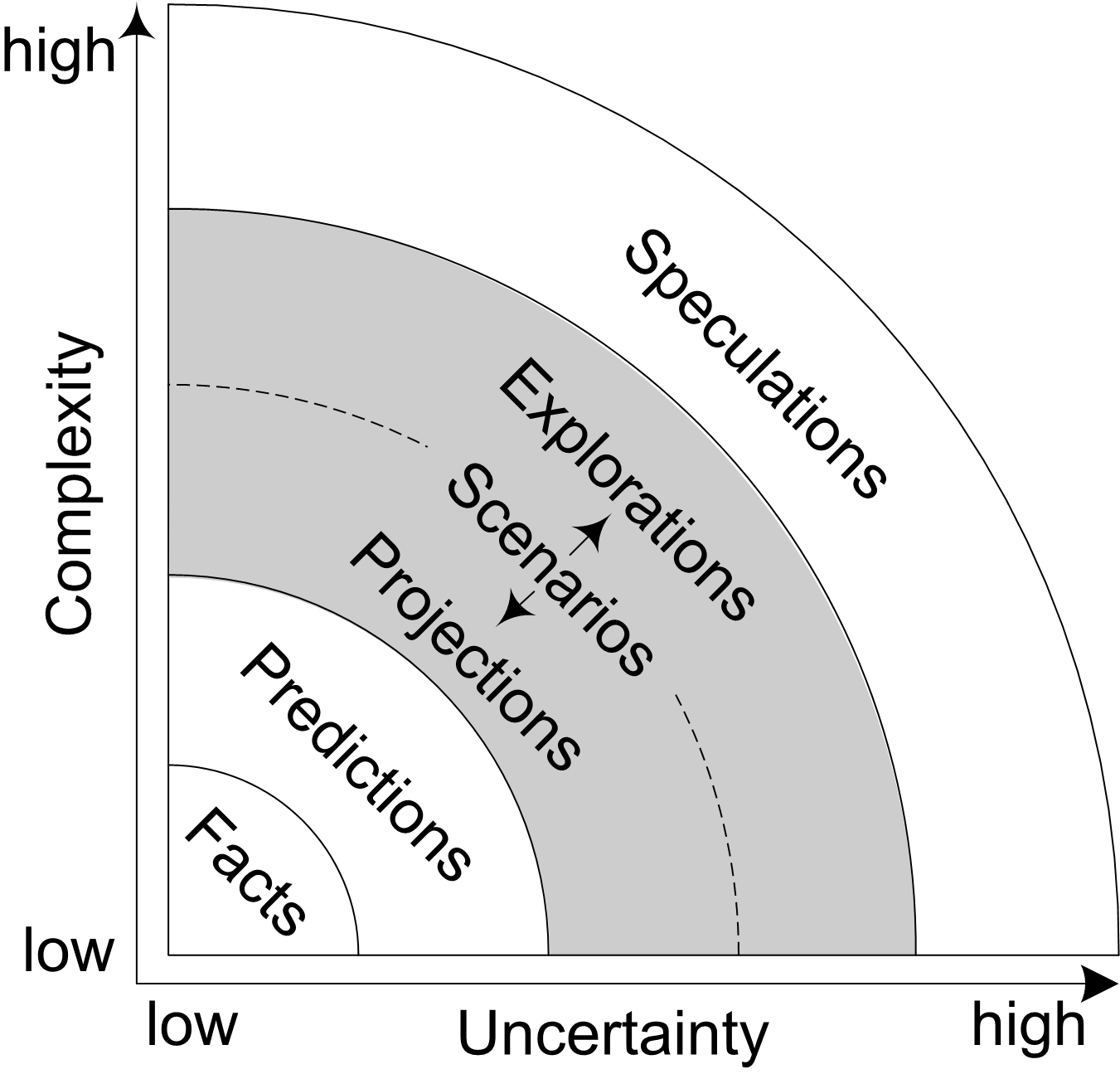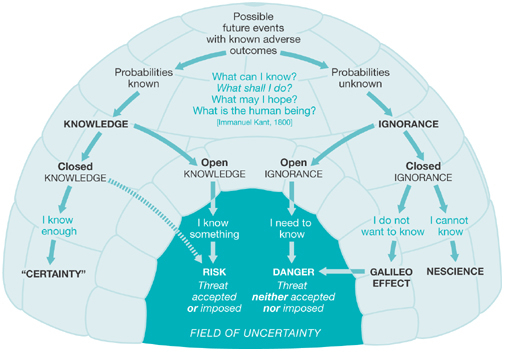The notion of ‘uncertainty’ is used in many scientific fields, often encompassing a multiplicity of related concepts. In broad terms, uncertainty may be defined as being any deviation from the unachievable ideal of completely deterministic knowledge of a relevant system (Walker et al. 2003).
Uncertainty characterises most assessment, policy and management processes that have unpredictable consequences. In a risk assessment context, the US Environmental Protection Agency refers to uncertainty as ‘our inability to know for sure’. In the Millennium Ecosystem Assessment, uncertainty is defined as ‘an expression of the degree to which a future condition (e.g. of an ecosystem) is unknown. Uncertainty can result from lack of information or from disagreement about what is known or even knowable’ (MA, 2003). Uncertainty may have different types of sources, from quantifiable errors in the data to ambiguously defined terminology or uncertain projections of human behaviour. Uncertainty measurements can, therefore, be represented by quantitative metrics (e.g. a range of values calculated by various models) or by qualitative statements (e.g. reflecting the judgement of a team of experts) (MA, 2003).
Several nomenclature systems have been developed for describing the different types of uncertainties. For example, Funtowicz and Ravetz (1990) explored the differences between three sorts of uncertainty:
• Inexactness, i.e. a technical level of uncertainty involving the random and systematic errors in empirical quantities;
• Unreliability, which is related to methodological uncertainties arising, for example, from an incomplete understanding and from the approximations made when describing the structural and functional characteristics of a system under study;
• Border with ignorance, which refers to an epistemological level of uncertainty (e.g. omissions of processes and parameters due to ignorance – ‘ignorance of ignorance’).
In a context of environmental contingencies and crisis, the checklist developed by De Marchi (1995) supports the identification and ranking of different types of uncertainty. As indicated in Table 1, there is an ethical dimension to decision-making and the handling of uncertainty when the lives of others are at stake (e.g. decision to approve new drugs or chemicals that have uncertain human health and environmental consequences). Within this context, Tannert et al. (2007) developed the ‘Igloo of Uncertainty’ (Figure 1) wherein dangers and risks are discriminated in the field of uncertainty – a danger is present regardless of choice, whereas a risk is either optionally accepted or imposed.

Table 1: Types of uncertainty in environmental emergencies (Source: De Marchi, 1995, available at http://www.nusap.net)

Table 2 Uncertainty, risk, ignorance and their relationship with different states of knowledge and suggested public policy action (Source: EEA, 2001)
Dealing with uncertainty
Adopting a precautionary approach in a context of uncertainty is often recommended as a strategy for public policy action. The precautionary principle is an overarching framework that governs the use of foresight in situations characterised by uncertainty and ignorance, where there are potentially large costs to both regulatory action and inaction (EEA, 2001). The sound application of the precautionary principle to issues of complexity, uncertainty and controversy requires the support of key elements of ‘good governance’, such as fairness, transparency and accountability (EEA, 2001). Scenarios and forward-looking studies are practical tools that can help to explore key uncertainties and their implications across a wider range of contrasting futures. As depicted in Figure 2, in the face of future uncertainties, scenarios and forward-looking assessments, and also visions, can help to structure and explore choices by revealing their possible long-term consequences, thus supporting strategic planning and decision-making.

Figure 2 The role of forward-looking assessments in dealing with complexity and uncertainty (Source adapted from Zurek and Henrichs, 2007)
References:
De Marchi, B., 1995, Uncertainty in Environmental Emergencies: A Diagnostic Tool, Journal of Contingencies and Crisis Management, 3 (2): 103-112.
European Environment Agency (2001) Late lessons from early warnings: the precautionary principle 1896-2000, Environmental issue report No 22 [Accessed Sept. 15, 2012 from http://www.eea.europa.eu/publications/environmental_issue_report_2001_22].
Funtowicz , S., Ravetz , J. (1990) Uncertainty and Quality in Science for Policy, Dortchert: Kluwer Academic Publishers.
Millennium Ecosystem Assessment (MA) (2003) Ecosystems and Human Well-Being: A Framework for Assessment, Washington, DC : Island Press.
Tannert, C. , Elvers , H.D., Jandrig , B. (2007) The ethics of uncertainty’ , EMBO – European Molecular Biology Organization reports, 8 ( 10 ): 892 – 896.
Walker, W., Harremoes, P., Rotmans, J., Van Der Sluijs, J., Van Asselt, M., Janssen, P., Krayer Von Krauss, M. P. (2003) Defining uncertainty. A conceptual basis for uncertainty management in model-based decision support, Integrated Assessment, 4 (1): 5 – 17.
This glossary entry is based on a contribution by Nuno Videira
EJOLT glossary editors: Hali Healy, Sylvia Lorek and Beatriz Rodríguez-Labajos


The project ENVJUSTICE has received funding from the European Research Council (ERC) under the European Union’s Horizon 2020 research and innovation programme (grant agreement No. 695446)